About all Cut Man’s stage has in common with Guts Man’s stage is assonance. In terms of design – and particularly as a starting point for a newcomer to Mega Man – it proves to be far more effective. It doesn’t front-load unreasonably difficult platforming challenges, it offers a variety of hazards, and it offers several strong hints about how you should go about defeating the boss at the end of the level.
Cut Man himself may not be quite as simple to defeat as the game’s first boss as Guts Man or Bomb Man, but he definitely belongs in the easier half of the Robot Masters. His strategy essentially consists of running back and forth while pausing at the edges of the room to toss his enormous blade, which behaves like a cartoon boomerang: It flies away from him, loops back, and returns to his hand regardless of where he may be at the moment.
Interestingly, Cut Man’s blade is integral. Unlike the Rolling Cutter you earn from him, which you can fire off in rapid success, he wields only a single blade, which he wears atop his head. This limitation arguably means Mega Man is better at using Cut Man’s weapon than Cut Man is – but it also makes the battle against him fairly reasonable. While the blade is aloft, Cut Man’s only offensive maneuver is to tackle you (as always, collisions damage you but not your enemies). He’s easy enough to leap, but the real trick of evading him comes from the fact that the blade is zeroing in on his location while he tries to plow into you. It’s imperative to learn the blade’s flight pattern so that you won’t jump heedlessly into the thing as you try to evade his aggressive jogging.
Cut Man is weak to Super Arm. Conveniently, Dr. Wily housed Cut Man in room with two blocks that you can lift and chuck at him. This is excellent strategic thinking, along the lines of Wart from Super Mario Bros. 2 installing a vegetable dispenser in his throne room despite being fatally allergic to vegetables. Damage values are all over the place in the original Mega Man; just as certain Robot Masters can end you in three hits, these two blocks will take down Cut Man. The sequels would rebalance weapon attack values considerably, but for the first game the team was still getting the hang of things – and, remember, they came from an arcade background, which means the idea of fair game balance was utterly foreign to them.
Still, this isn’t amateur hour. Cut Man’s stage begins with a series of small buildings blocked up by those rock cubes that only the Super Arm can lift. You can’t get through this blockade without the Super Arm (or Elec Beam, but trying to beat Elec Man without the Rolling Cutter is one of the game’s most difficult tasks, so…), which means that you need to take the more laborious ladder route up and down if you haven’t defeated Guts Man.
On the other hand, if you do have the Super Arm, this stage opens with a perfect training ground. Not only can you create a shortcut by picking up the blocks that obstruct the way, you can easily take out the flying enemies who swoop down at you in a triangle formation by hucking the rocks at them. The blocks disintegrate in midair, creating a shrapnel spread that extends upward as it flies forward, essentially pelting everything within a 30-degree arc ahead and up. That’s precisely the correct angle of attack to wipe out the flying enemy formations. It’s a perfect opportunity to learn how this weapon works, not only demonstrating the advantage of using the right tool for the job but also prepping you for your fight against Cut Man.
Otherwise, this sequence teaches you how to jump and shoot enemies, because these guys keep circling back and forth and dive-bombing you until you die.
Ladders factor prominently into Cut Man’s stage, as much of the level involves an ascent. It’s not as aggressive about ladders as Elec Man’s stage, though; your ascent is broken up into different platforming tasks as you climb. Many of these enemies you face are predictable, pattern-based foes such as the turrets that emerge from their indestructible shells to fire at you and the red, lantern-like robots that move back and forth along a single track (either horizontal or vertical) at regular intervals. Amidst these foes, which can be beaten easily with patience, you also have more unpredictable threats like the blue Fleas that hop around erratically. A simple screen like this makes use of several of Mega Man’s basic skills and teaches players when to be aggressive and quick and when to be more patient – a simple but effective bit of level design and enemy placement.
Interestingly, you’ll occasionally come across these devices: Rolling Cutter dispensers. Blades fly out of the open slot, arcing upward toward Mega Man’s location. They have a fairly limited horizontal range, but they also spill out at a fairly rapid clip, so you need to time your movements to squeeze between blades, and keep moving once you commit to the action.
Aside from the flame pillars in Fire Man’s stage, these blades mark the only instance of a Robot Master’s weapon appearing mid-stage as an environmental hazards unconnected with any particular enemy. They’re strange yet interesting.
This screen is another example of really great level design: It seems utterly overwhelming at first, with four moving enemies that can span the entire screen. But again, they move in a regular, predictable, limited, consistent pattern. You’re completely safe where you enter the screen, at the lower left, and will be in no danger until you take action. You can take out three of the enemies in a single action by tossing the brick in the center of the room with the Super Arm, though of course you need to make sure the robots are all in the proper places before you make the throw.
There’s a tradeoff involved in using the Super Arm, too. The brick is blocking the center robot and limiting its movement, keeping Mega Man safe if he sticks to the left. If you remove the block, it can traverse the entire screen, leaving you potentially vulnerable if you don’t destroy the robot immediately.
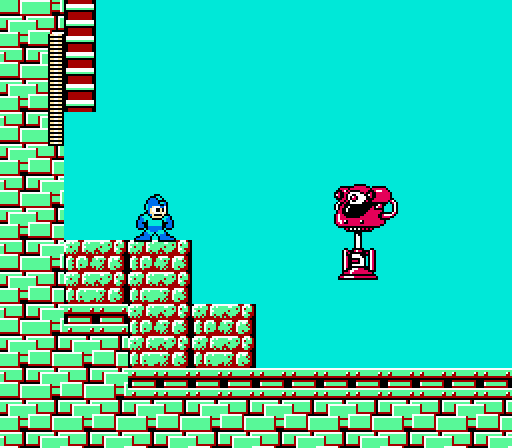
And finally, the obligatory Big Eye encounter. While this setup bears some similarity to the one at the end of Guts Man’s stage, with Mega Man dropping from above left and facing a big stompy robot approaching from the right, it stands apart thanks to the fact that you can chuck bricks at it. They do heavy damage to the Big Eye and make this encounter much less harrowing than the other.
In short, you can definitely see why Mega Man‘s creators placed Cut Man’s stage as the default cursor position on the level select screen. It presents first-time players with a number of diverse challenges, yet none that feel insurmountable. With the P cannon, Cut Man proves difficult but not impossible. Meanwhile, the abundance of interactive bricks that can be heaved with the Super Arm gives the player ample opportunity to practice with the weapon to which the stage boss is vulnerable. It works both as a first stage and a challenge to be dealt with further into the stage progression chain, and the experience varies considerably depending on whether or not you’ve beaten Guts Man. In a lot of ways, Cut Man’s stage is the gold standard for Mega Man level design, and the series would gravitate more toward this approach discipline than to the style seen in Guts Man’s stage.
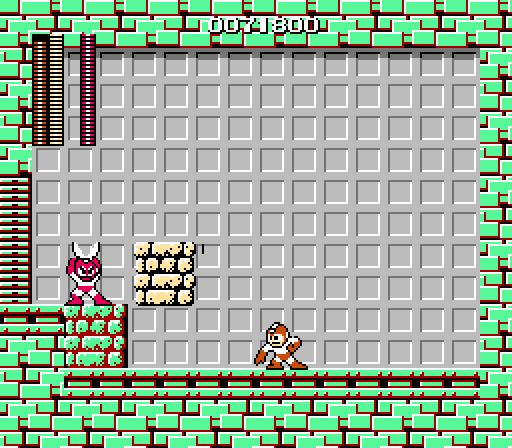
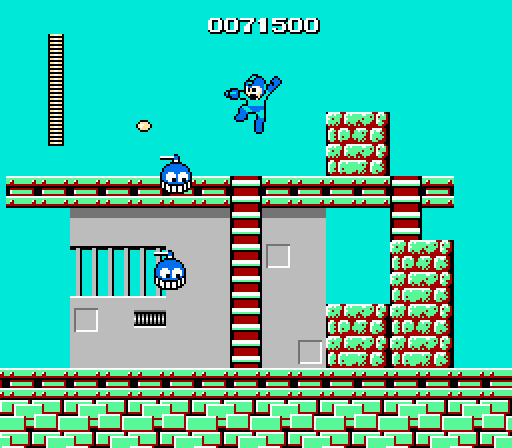
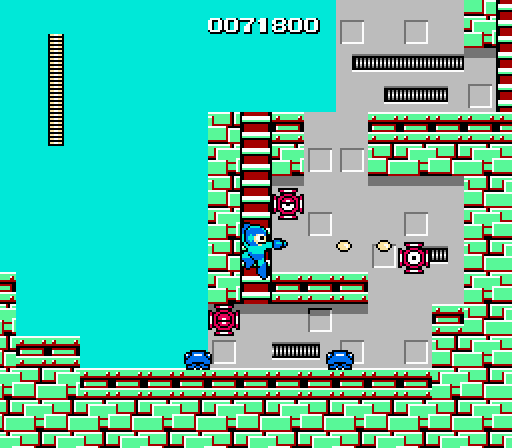
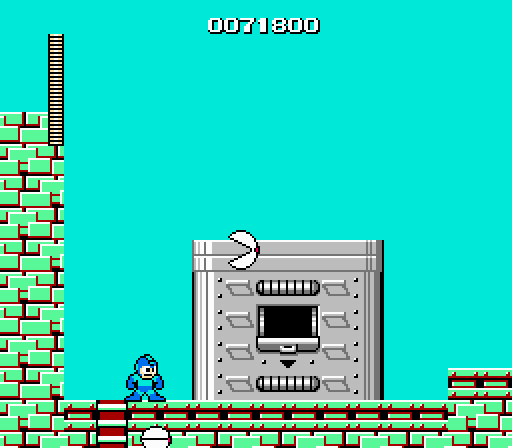
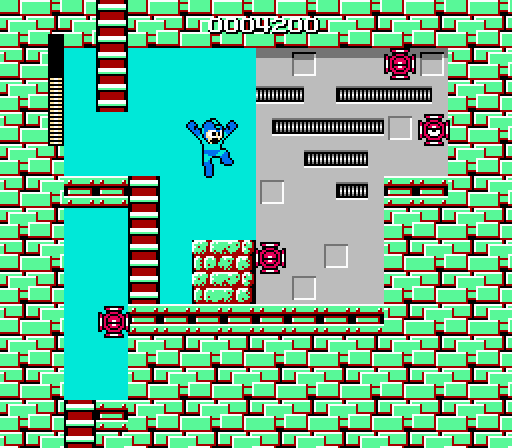
Awesome insights as usual. But I just realized that it is never very clear what the Super Arm really does when you get it. I think I only realized what it did when I was experimenting with every weapon to move the block guarding the platform-maker in Elecman’s stage and suddenly the block started glowing. Then I started seeing the blocks everywhere. So, while the opportunities to throw those bricks are in Cutsman’s stage, I never saw them as anything but part of the scenery. Maybe it would have been helpful for Gutsman to actually lift blocks in his room to demonstrate his power, rather than making them fall from offscreen.
The first few times I played the game, I honestly didn’t even figure out that I was collecting weapons from fallen Robot Masters—I hadn’t read the manual, and there was no prompt in the game to really let me know I had taken anything from the battles. Adding “weapon get” screens in subsequent titles was a great idea.
Reggie- You’re right, the game doesn’t give you much information about the Super Arm. A “Get equipped”-style screen like the ones from MM2 onwards would’ve been helpful in this case (Though the “You got a weapon” screens didn’t start demonstrating a weapon’s use until Mega Man 6).
Also, it has the best music.